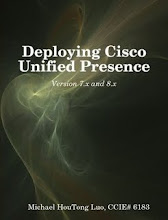What is "Change Notification"? And how does it affect products' functionality?
Typical symptom of "Change Notification Issue" is: the changes you made didn't seem to take effect, including:
#1 You add a new DN (Directory Number) to CUCM. But you got fast busy when calling that DN.
#2 You try to reset the phone from GUI. But the phone didn't get reset.
#3 You updated the information on CUCM (such as PIN#, line association, etc.). But CUPS didn't get those changes.
...
"Change Notification" is one component notify another component that changes have been made. The other component should react to this notification.
For example, when you add a new DN to CUCM. The changes were made to database. Database component should send notification to the call routing component. So the call routing function could work properly (calls can be routed to the new DN).
If change notification was failed (or delayed), the call routing component will use outdated information to route calls. Thus calls to new DN would failed.
How do you know if there's a change notification issue? If the components are on the same box, you may use the command "show tech notify"
An example output would be link below:
32 I 0 P 118 H 118 T 118 S 80 ccm
...
38 I 0 P 119 H 119 T 119 S 27 EPAS_SyncAgent[10.88.229.209]:32958
The line that begin with numbers (32, 38, ...etc.) represent clients (applications) subscribed to change notify
"32" means it is the 32 client slot on this server.
"I 0" means there are 0 messages in shared memory to be processed by this client.
"P 118" means 118 messages have been processed.
"H 118" means the "Head" message position is 118.
"T 118" means the "Tail" message was in position 118.
This is the optimal situation: 118-118=0 (nothing to be processed).
“S 80 ccm” means there are 80 tables subscribed by this client and the client name is ccm (callprocssing).
You may also use RTMT to see the CN (Change Notification) queued. If you saw non-zero value in queue, either the server was busy, or you got CN issues. Restarting corresponding process (such as ccm) normally would clean up the queue and solve the problem.

Change notification across different boxes is a little bit complex. CN was sent via IPSEC tunnel in this scenario. IPSEC was controlled by Cluster Manager. Trust relationship was established during installation (when you add a box into cluster).
In order to add a new server into a cluster, two requirements have to be met:
1) The hostname of the new box needs to be presented in the Publisher's server list or application list. (this can be done manually or automatically depends on the server you try to add).
2) You need to know the cluster "secret password". The password needs to be entered during installation (of the new box).
If either one was changed after installation, the trust would be broken. You can verify that by looking at "Cluster Manager" logs.
If trust was broken, change notification won't work. For example, changes made on CUCM didn't populate to CUPS. Restart Sync Agent would force a synchronization, which is not affected by change notification or IPSEC.


great post, insight into a topic not frequently covered outside of Cisco
ReplyDeleteHi,
ReplyDeleteI have the followiung issue as stated below, just wondering if anybody can help me.
Call Manager ver 6.1 - Publisher failed Services didn't migrate over to the Subscriber
Great blog by the way
Cheers
Sean